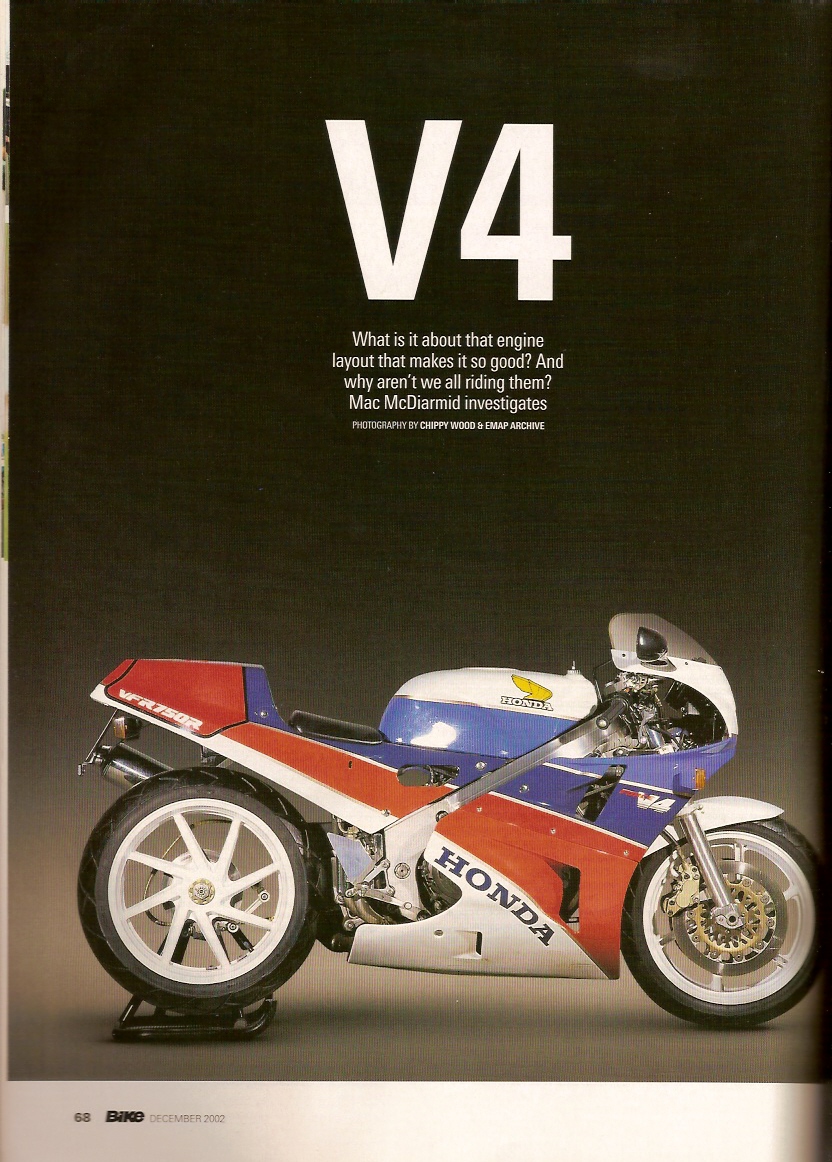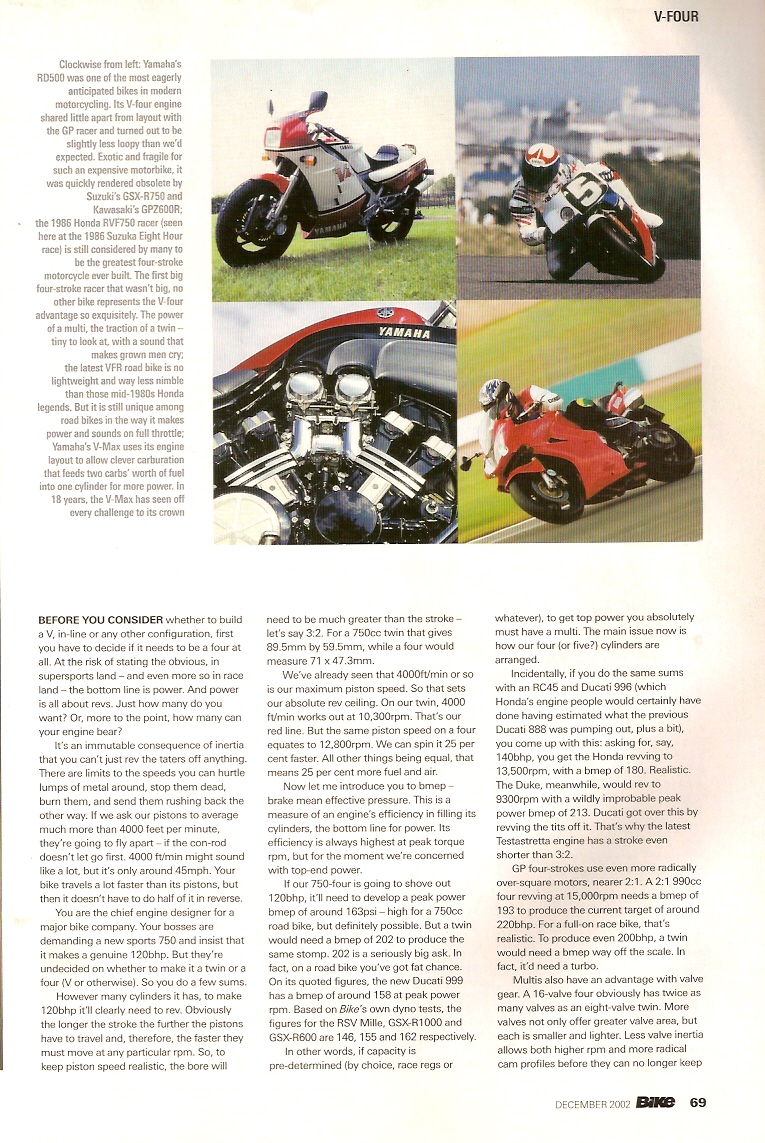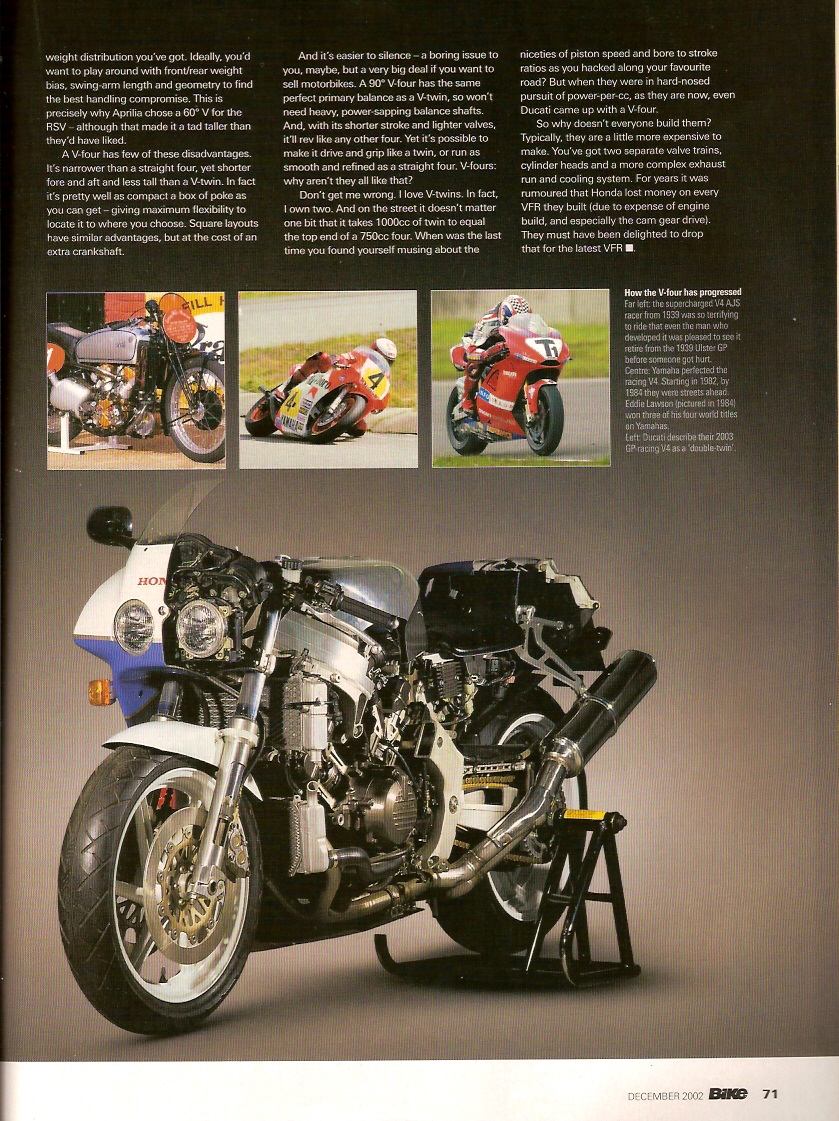| Author | Message | ||
Dynasport |
I have accepted as general knowledge that, for a given engine displacement, a v-twin engine will have better torque, but lower peak hp, lower redline, and less top end performance. I have not understood the reason behind these performance differences, however. Thinking about it, I began to wonder if it was because of the difference in weight/mass of each piston/connecting rod assembly. Or does it have to do with some other characteristic of the engine configurations? Thanks | ||
Not_purple_s2 |
It's mostly due to the stroke. V-twins typically have a longer stroke than inline engines. Shorter strokes allow higher revs and more peak horsepower. Longer strokes have more momentum which equates to more torque. Think of the difference between a claw hammer and a sledge hammer. Also there is more weight in each cylinder's rotating assembly (piston, connecting rod, and crank counter weight). The total weight of the rotating assembly might be more in the inline but it's divided into 4 cylinders rather than just 2. This helps the inline rev faster than the twin. (Message edited by Not_Purple_S2 on October 23, 2007) | ||
Ridrx |
I always wondered if the longer "dead time" between power pulses(combustion strokes) on a twin contributed to that equation. | ||
M1combat |
Well... the time between top dead center is defined by RPM. Not engine characteristics. HP=(torque X RPM)/5252 That's why all HP/tq dyno plots always cross at 5252 RPM. That's also why if you can keep a decent amount of torque at high RPM's you make HP. Google "Swept Volume". | ||
Wolfridgerider |
This sounds like a question for Abe. | ||
Old_man |
I believe a 4 could be designed to make more torque than a 2 of equal displacement at the same rpm. | ||
M1combat |
"and less top end performance. " That may be true at the top, but what twins do down low mitigates that disadvantage somewhat. Twins tend to get more traction coming out of corners and they tend to have a bit more acceleration just after the shift. This allows a rider on a twin (or a V engine) to gain a bit more speed early on. The inline then has to get to that speed, gain more speed AND make up the distance they lost coming out of the turn, then make the pass. Exit speed is generally the king of racing unless you're racing on a very fast racetrack like Monza. That's not to say that HP has no place in racing though... quite the opposite. It's the area under the usable power curve that's important. Not the peak hp number as such. | ||
Josh_ |
1300 I4 Hmm, anyone find a stock big twin (1340cc) dyno chart? | ||
Wolfridgerider |
http://www.tmanperformance.com/dynoruns.htm Not so stock..... (Message edited by wolfridgerider on October 24, 2007) | ||
Brumbear |
what would you call stock cause I highly doubt theres not a ton of stuff done to these I4 alredy or out of the box if you will | ||
Coal400 |
Longer stroke = longer crank, which will have a greater mechanical advantage. This is where the torque comes from. Think of a meat grinder with a very small handle - much harder to grind. Then get one with a very big handle - the the longer the stroke the more torque. Larger cranks also make for increased piston speeds due to the greater distance that the piston will travel each stroke. This is one of the reasons why you would design the rest of the engine to operate at a lower RPM - the engine could be designed to make more power at higher RPM but it would not be without the sacrifice of longevity or potential catastrophe. Many short stroke, high RPM engines are usually "ON" or "OFF" in terms of power. This is because the more RPM an engine is designed to operate within, the greater the compromises. What gains you make at the very top of the RPM usually result in a sacrifice at the bottom. There are technologies like variable valve timing, and dynamic plenum designs have been designed to lessen the compromises on high RPM engines.... Wait... I'm starting to babble... The "ON"/"OFF" characteristic of the short stroke, high RPM, engine is more difficult to control. Think of replacing your throttle with a toggle switch (radical example but you get the point) I'm anticipating 'bstrd remarks about crank and stroke  | ||
Josh_ |
The one I linked had a stock 1300cc FJR dyno chart. Someone wanted to compare to a same-size vtwin but I could not find a dyno chart. Note the FJR's power "hole" at 4500RPM. Other that than it makes 80+ft/lbs from 3700-8000RPM, peaking at 90ft/lbs 6500-7500RPM. I'm thinking this might be more torque than a stock 1340cc vtwin... | ||
Blake |
One of the opening assumptions is mistaken. A four cylinder engine can provide just as much torque if it is endowed with a longer stroke. Take a look at the torque generated by the current GSXR1000 engine for instance. Does the Ducati 999 or any other twin beat it? By much? Even with the exact same stroke as a similarly configured two cylinder engine, a four cylinder engine, will provide higher performance. Why? The four cylinder engine will have twice the number of intake and exhaust valves and thus a greater efficiency for filling the combustion chamber with more air-fuel charge. Yes the valves are smaller in diameter, significantly so, but in total they provide a significant increase to engine pumping efficiency. Also consider that twice as many and smaller combustion chambers with twice as many spark plugs in total provide more efficient combustion at very high engine speeds. | ||
Rainman |
But they don't get as good gas mileage. | ||
Spike |
As Blake said, the four can produce the same amount of torque when the variables (displacement, stroke, etc.) are right. Torque output is tied almost directly to stroke and displacement, where power is tied more to displacement and RPM. Motorcycle.com has a dyno chart from their '04 open class shoot out featuring twins and fours that demonstrates this nicely, but ever since they changed the layout of their site I've had a terrible time finding and linking to the data. This article is actually V4 specific, but the technical discussion applies to all engines and it gives a good outline of the advantages of various engine layouts:     | ||
Jlnance |
Others have said all this, but it might help to phrase it like this. If you want a lot of low end torque, you want an engine with a long stroke. If you want power at the top, you need an engine that spins quickly, and therefor can not have a long stroke. Now you're designing an engine. If you want a long stroke, is it easier to get that from a twin or a 4 cyl? The cylinders are twice as large in a twin, for a given displacement, so you get a longer stroke "just because." If you want to spin it fast, which is easier? The cylinders are half the size in an IL4, so the bore and stroke are smaller, the pistons are lighter, and that makes it easier to spin. The IL4 is also inherently balanced, so it isn't going to shake itself apart like a twin would if you spun it fast. | ||
Gschuette |
I thought an inline 6 was balanced on its own but a 4 would still need some form of counter weight. Am I wrong? | ||
Xl1200r |
I thought an inline 6 was balanced on its own but a 4 would still need some form of counter weight. Am I wrong? I can't speak to all 4 cyl, but in general, the pistons for cylinders 1 and 4 move together, and the pistons for cylinders 2 and 3 move together. 2 and 3 are 180 degrees crank rotation from 1 and 4, for for every piston you have moving upwards, you have one moving downwards at all times. | ||
Rocketman |
Unless you take an IL 4 into 'Big Bang' territory! The crankshaft boggles  Rocket |